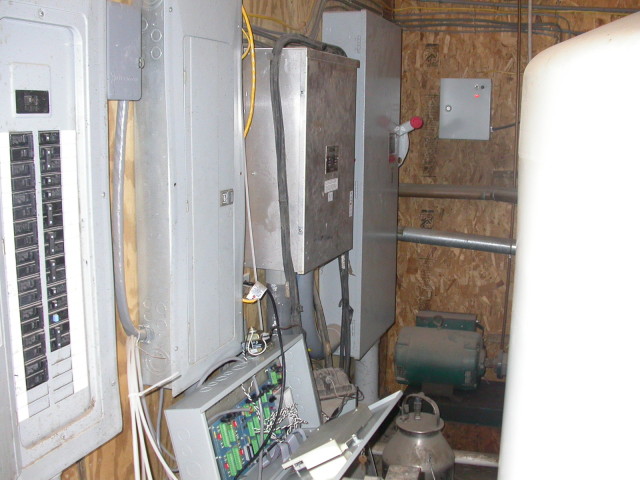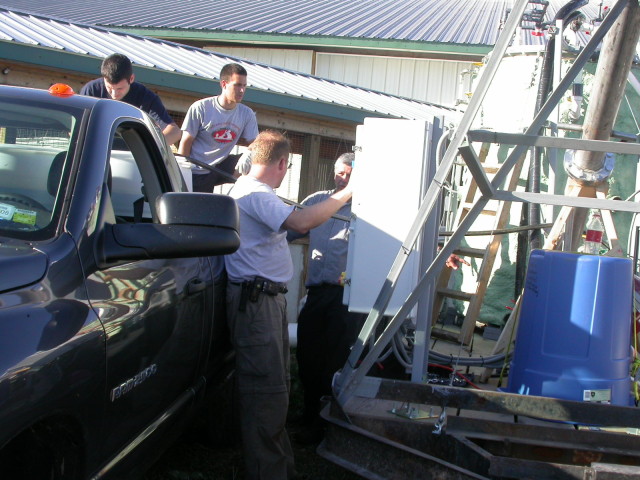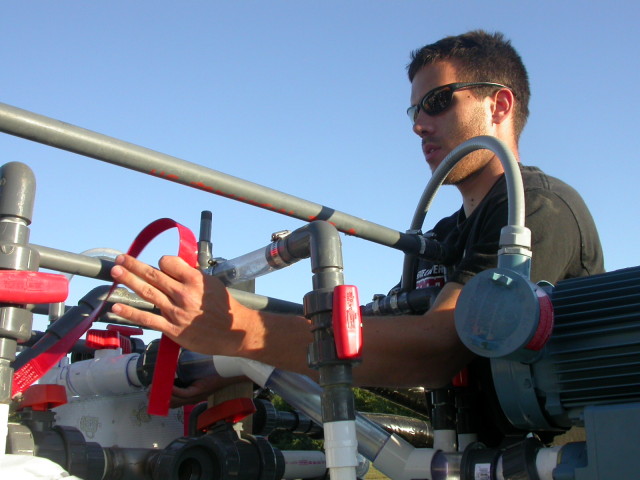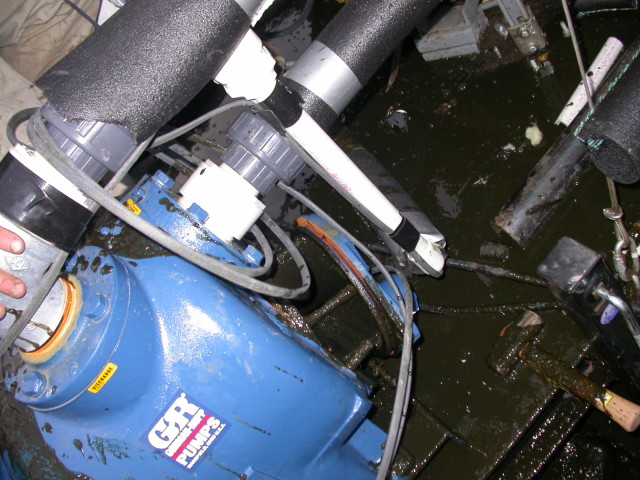Wrenching on the digester
It seems that whatever project I get into inevitably ends up involving a fair amount of manual labor. Possibly because I really enjoy solving problems, but also because the best way to improve a process, product, or situation is to be in the middle of it to understand what is happening first hand. This gives my imagination healthy fodder on which to work.
 First thing I was told to do was gather farm load data, which means installing this data logger on the farm's main electrical service. I would like to issue a note of thanks for the very understanding and friendly people who work on the farm where we were doing our work. The data logger was installed on the farm's 240 V split phase service, using CT's in the wire way below the panels, and a voltage sense installed on a spare 2-pole breaker in the main panel.
First thing I was told to do was gather farm load data, which means installing this data logger on the farm's main electrical service. I would like to issue a note of thanks for the very understanding and friendly people who work on the farm where we were doing our work. The data logger was installed on the farm's 240 V split phase service, using CT's in the wire way below the panels, and a voltage sense installed on a spare 2-pole breaker in the main panel.
 When we first installed the digester, which was literally the third day of a three-day sleepless stretch, we needed to prime it with municipal sludge. This process pre-loads the tank with healthy and happy bacteria so we have a shorter startup time. Dave, standing in the truck bed with his hand on his knee, went to the Watertown water treatment plant and picked up four 55 gallon drums of this material. Wastewater plant liquid effluent is actually very clean smelling. The smell is more like fresh tilled earth after rain than like anything having to do with manure. Guillaume, Dave, me, and Prof. Grimberg are the ones in the photo, from left to right. This was also my first introduction to Moyno progressive cavity pumps, which are among the most clever pumps in existence for pumping thick and gritty materials.
When we first installed the digester, which was literally the third day of a three-day sleepless stretch, we needed to prime it with municipal sludge. This process pre-loads the tank with healthy and happy bacteria so we have a shorter startup time. Dave, standing in the truck bed with his hand on his knee, went to the Watertown water treatment plant and picked up four 55 gallon drums of this material. Wastewater plant liquid effluent is actually very clean smelling. The smell is more like fresh tilled earth after rain than like anything having to do with manure. Guillaume, Dave, me, and Prof. Grimberg are the ones in the photo, from left to right. This was also my first introduction to Moyno progressive cavity pumps, which are among the most clever pumps in existence for pumping thick and gritty materials.
 As part of the sand separation system, we needed to mix biogas in with the tank. This is a photo of Dave atop the tank working with a strap wrench to secure pipes during the blower install day. This system, and it's PVC fittings and thread couplings had a number of problems related to seasonal temperature changes.
As part of the sand separation system, we needed to mix biogas in with the tank. This is a photo of Dave atop the tank working with a strap wrench to secure pipes during the blower install day. This system, and it's PVC fittings and thread couplings had a number of problems related to seasonal temperature changes.
 The trunk of my 1990 Toyota Celica, having recently surpassed 200,000 miles. This car made several digester visits. Present in the trunk here was the Moyno pump, at top, which although nice was too small and kept getting plugged, and an attempt at a recirculation pump, which also kept getting plugged. I go to Canada frequently for swing dancing, and at one point I went through Customs when returning to the US having forgotten to empty my trunk of odd pieces of manure-encrusted equipment. The border guard was amused.
The trunk of my 1990 Toyota Celica, having recently surpassed 200,000 miles. This car made several digester visits. Present in the trunk here was the Moyno pump, at top, which although nice was too small and kept getting plugged, and an attempt at a recirculation pump, which also kept getting plugged. I go to Canada frequently for swing dancing, and at one point I went through Customs when returning to the US having forgotten to empty my trunk of odd pieces of manure-encrusted equipment. The border guard was amused.
 Guillaume working the big tractor-driven centrifugal pump. This pump has three gate valves on it that can be used to stir or pump up the big pipe, where it drops into a manure spreader. This pump apparently needs replacing quite frequently, at least by farm implement standards. Before they load their spreader, they agitate the lagoon to try and get as much sand out of the lagoon as possible. We did the same thing to try and get a uniform sample of manure into our tank with each feeding.
Guillaume working the big tractor-driven centrifugal pump. This pump has three gate valves on it that can be used to stir or pump up the big pipe, where it drops into a manure spreader. This pump apparently needs replacing quite frequently, at least by farm implement standards. Before they load their spreader, they agitate the lagoon to try and get as much sand out of the lagoon as possible. We did the same thing to try and get a uniform sample of manure into our tank with each feeding.
 On the subject of 'That's not mud', this was our large 500 GPM chopper pump, which was supposed to force effluent through 3/4 inch PVC. The pump wasn't performing to spec, so we opened it up to make sure it wasn't clogged. Well, the pump wasn't. All the pipes leading in and out, however, were clogged quite solidly with sand. From this experience the people working on the project learned a great deal about what you can and cannot pump sand laden dairy manure through.
On the subject of 'That's not mud', this was our large 500 GPM chopper pump, which was supposed to force effluent through 3/4 inch PVC. The pump wasn't performing to spec, so we opened it up to make sure it wasn't clogged. Well, the pump wasn't. All the pipes leading in and out, however, were clogged quite solidly with sand. From this experience the people working on the project learned a great deal about what you can and cannot pump sand laden dairy manure through.
 My favorite raincoat gets ruined. It was around 12 degrees Fahrenheit and I was standing in the digester tank itself, shoveling the sand-laden manure over the edge. It turned out that we had more sand than we expected, and that the sand removal wasn't working quite as well as we had hoped. We needed to bring it back to Clarkson, and the trailer was not movable with the tank full of sand. The only solution: Shovel. It took me a little over two hours to shovel out 3' worth of quite heavy sand laden manure. I have a much larger appreciation for the kind of people who inspired the song .16 tons. after this. The tank didn't smell quite as bad as it perhaps could, although maybe that's just the hydrogen sulfide talking. We also carefully and continuously took samples from within the tank to characterize the stratification in the levels in the tank. Numerous epiphanies came from this experience, but more on those later.
My favorite raincoat gets ruined. It was around 12 degrees Fahrenheit and I was standing in the digester tank itself, shoveling the sand-laden manure over the edge. It turned out that we had more sand than we expected, and that the sand removal wasn't working quite as well as we had hoped. We needed to bring it back to Clarkson, and the trailer was not movable with the tank full of sand. The only solution: Shovel. It took me a little over two hours to shovel out 3' worth of quite heavy sand laden manure. I have a much larger appreciation for the kind of people who inspired the song .16 tons. after this. The tank didn't smell quite as bad as it perhaps could, although maybe that's just the hydrogen sulfide talking. We also carefully and continuously took samples from within the tank to characterize the stratification in the levels in the tank. Numerous epiphanies came from this experience, but more on those later.
 Me manning the tractor for the Big Manure Pump. The farm used this tractor to pump manure, and only pump manure. Never used a tractor before. Not unlike any other large motorized piece of equipment, just needing more levers to properly operate it
Me manning the tractor for the Big Manure Pump. The farm used this tractor to pump manure, and only pump manure. Never used a tractor before. Not unlike any other large motorized piece of equipment, just needing more levers to properly operate it

